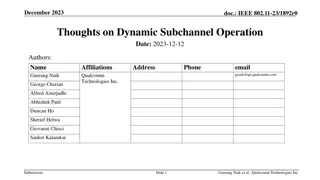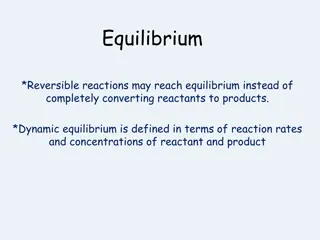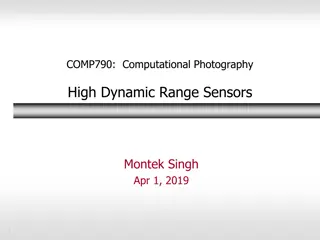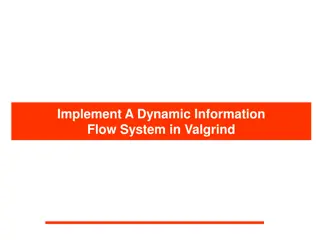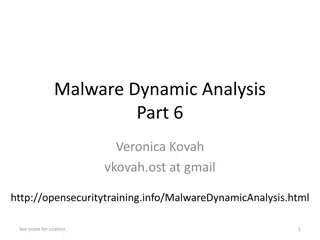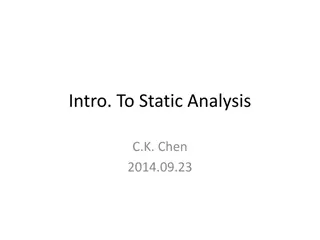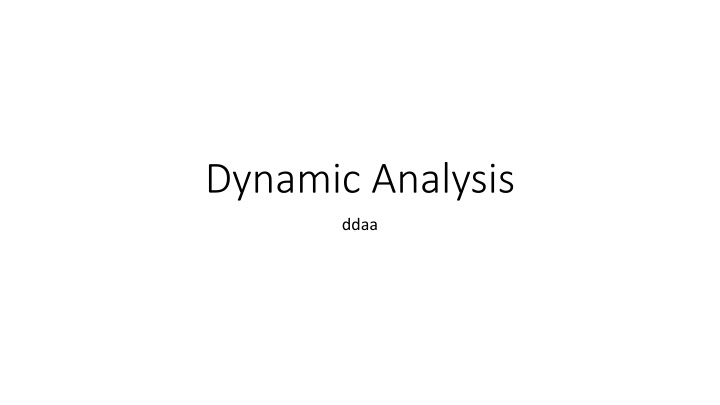
Dynamic Program Analysis for Software Examination
Explore dynamic program analysis, a method of examining computer software by executing programs on a processor to observe memory contents, registers, and more. Learn about the pros and cons, alongside tools like ltrace and strace for intercepting system calls. Delve into debugger usage and setting breakpoints for detailed analysis and modification of programs.
Download Presentation

Please find below an Image/Link to download the presentation.
The content on the website is provided AS IS for your information and personal use only. It may not be sold, licensed, or shared on other websites without obtaining consent from the author. If you encounter any issues during the download, it is possible that the publisher has removed the file from their server.
You are allowed to download the files provided on this website for personal or commercial use, subject to the condition that they are used lawfully. All files are the property of their respective owners.
The content on the website is provided AS IS for your information and personal use only. It may not be sold, licensed, or shared on other websites without obtaining consent from the author.
E N D
Presentation Transcript
Dynamic Analysis ddaa
What is it? Dynamic program analysis is the analysis of computer software that is performed by executing programs on a real or virtual processor. Examine the process during execution Observe registers, memory contents, , etc. If you will analysis a malware, it should run in a VM.
Pros 1. Observe the status of process during executing. 2. Control the flow of process arbitrarily. 3. Overcome the shell or obscure code. 4. Find the problem happened in library.
Cons 1. Influence the real program 2. Code coverage depends on input data. 3. Need an environment for executing program.
ltrace It intercepts and records the dynamic library calls which are called by the executed process and the signals which are received by that process
strace It intercepts and records the system calls which are called by a process and the signals
Other tools Process monitor (windows) Process explorer (windows) valgrind http://zh.wikipedia.org/wiki/Valgrind
Scenario /home/xxx/flag not found. We don t know which port the program bind.
Your turn http://secprog.cs.nctu.edu.tw/files/phantom Try to get the flag :p
Debugger Windows windbg, ollydbg, immunity debugger, ida pro, Usage is almost the same, expect windbg. Linux gdb gdbtui kgdb We ll focus on gdb in class but you should learn how to use one of windows debugger at least.
Debugger (cont.) Set breakpoints Once breakpoint is set to certain address, program will stop executing and send signal to debugger Control process Until arriving the instructions we interested Dump memory or information registers, stack, heap, or anything in memory map. Modify something, such as register, memory content. It may also change the control flow.
gdb - set breakpoints break [location] [condition] Set breakpoint at specified line or function. break *0x08045566 if $eax = 5566 watch [memory address] [condition] A watchpoint stops execution of your program whenever the value of an expression changes. enable | disable enable/disable breakpoint delete number delete # breakpoint
gdb - control process run Start debugged program. continue Continue program being debugged, after signal or breakpoint. nexti Next instruction. stepi Next instruction, but step into the function. finish run until return
gdb - Dump memory x/fmt [address] Examine memory fmt = repeat count + format letter + size letter x/10xw 0xffff5566 print [address] Print value of expression
gdb - modify something set [address]=[value] Evaluate expression EXP and assign result to variable VAR, using assignment syntax appropriate for the current language set $eax=5566 set *0xffff5566 = 5566 set can be used to configure some gdb options. set follow-fork-mode parent|child set disassembly-flavor att|intel
gdb - information info registers register information info stack call flow info breakpoint breakpoint information info args/local display variable (with debug info) info proc map display memory region
gdb - others attach [pid] Attach to a process or file outside of GDB. disassemble [address] Disassemble a specified section of memory. list List specified function or line. display Print value of expression EXP each time the program stops. display/i $pc
Stack frame int main(){ f1(); return 0; } void f1(){ int v1,v2; f2(v1,v2,100); } void f2(int a1,int a2, int a3){ printf( %d\n%d\n%d .a1,a2,a3); }
Breakpoint detail 0804867f <main>: 804867f: 8048680: 8048682: ===================================================== 8048682: cc 8048683: e4 f0 55 89 e5 83 e4 f0 push %ebp mov and $0xfffffff0,%esp <= bp %esp,%ebp int 3 ???????????
Anti-debugger shelling IsDebuggerPresent signal ptrace(PTRACE_TRACEME, 0, 1, 0)
Reference http://en.wikipedia.org/wiki/Dynamic_program_analysis http://repo.hackerzvoice.net/depot_ouah/linux-anti-debugging.txt https://github.com/hellogcc/100-gdb-tips/tree/master/src http://www.cs.fsu.edu/~redwood/OffensiveComputerSecurity/reversi ng/FSU_Reversing.pdf

![[PDF⚡READ❤ONLINE] Planet Mercury: From Pale Pink Dot to Dynamic World (Springer](/thumb/21549/pdf-read-online-planet-mercury-from-pale-pink-dot-to-dynamic-world-springer.jpg)



